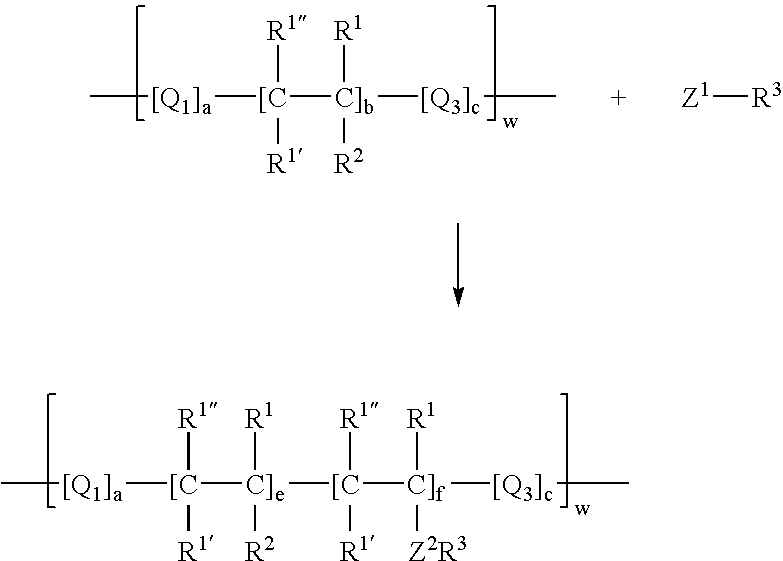Process for incorporating poorly substantive paper modifying agents into a paper sheet via wet end addition
- Summary
- Abstract
- Description
- Claims
- Application Information
AI Technical Summary
Benefits of technology
Problems solved by technology
Method used
Image
Examples
example 1
Preparation of Glyoxylated PAM / 2-(2-aminoethoxy)ethanol
[0114]50 mL of a 6.5 wt. % solution of a commercially available cationic glyoxylated polyacrylamide, Parez 631 NC®, and 200 ml of distilled water was charged to a 1-liter round bottom flask equipped with a mechanical stirrer and a 500 ml addition funnel. 0.57 grams of 2-(2-aminoethoxy) ethanol was weighed into a 400 cc beaker and 250 ml of distilled water added. The amine functional polyhydroxy compound was then added dropwise to the stirred glyoxylated polyacrylamide solution over 42 minutes at ambient temperature to the glyoxylated PAM. The solution turned very cloudy and a heavy precipitate was formed in the reaction vessel indicating that the reaction product was insoluble in water.
example 2
Preparation of Glyoxylated PAM / 3-amino-1,2-propane diol copolymer
[0115]50 mL of a 6.5 wt. % solution of a commercially available cationic glyoxylated polyacrylamide, Parez 631NC®, and 200 ml of distilled water was charged to a 1-liter round bottom flask equipped with a mechanical stirrer and a 500 ml addition funnel. 0.42 grams of 3-amino-1,2-propane diol (97%, Aldrich Chemical Co.) was weighed into a 400 cc beaker and 250 ml of distilled water added. The amine functional polyhydroxy compound was then added dropwise to the stirred glyoxylated polyacrylamide solution over 60 minutes at ambient temperature. After addition was complete the slightly cloudy solution was transferred to a 500-ml volumetric flask and diluted to the mark with distilled water.
example 3
Preparation of Glyoxylated PAM / Tris(hydroxymethyl) aminomethane
[0116]The same procedure as that of Example 1 was followed except that 0.66 grams of tris(hydroxymethyl)aminomethane was used as the amine compound and was added over a period of 57 minutes to the glyoxylated PAM.
PUM
| Property | Measurement | Unit |
|---|---|---|
| Fraction | aaaaa | aaaaa |
| Fraction | aaaaa | aaaaa |
| Fraction | aaaaa | aaaaa |
Abstract
Description
Claims
Application Information
 Login to View More
Login to View More - R&D
- Intellectual Property
- Life Sciences
- Materials
- Tech Scout
- Unparalleled Data Quality
- Higher Quality Content
- 60% Fewer Hallucinations
Browse by: Latest US Patents, China's latest patents, Technical Efficacy Thesaurus, Application Domain, Technology Topic, Popular Technical Reports.
© 2025 PatSnap. All rights reserved.Legal|Privacy policy|Modern Slavery Act Transparency Statement|Sitemap|About US| Contact US: help@patsnap.com



